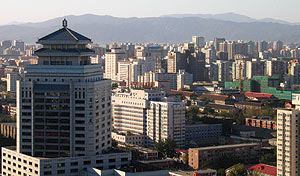Earlier this year, during an urban development forum at a university in Belfast, Ireland, the New York-based architect Daniel Libeskind ruffled feathers when he admonished fellow architects not to accept commissions from China and other so-called repressive regimes. “I think architects should take a more moral stance,” he proclaimed. The Polish-born architect’s speech incited backlash from colleagues and charges of hypocrisy—some pointed to his Hong Kong project, the now-under-construction Creative Media Centre—but his remarks incited a question that can leave some architects feeling squeamish: Is it ethical to accept commissions from authoritarian governments with poor human rights records?

It is a dilemma that more firms are facing as globalization puts foreign markets in reach, and non-democratic Asian and Eastern European countries direct their attention toward large-scale urban development. Beijing is a prime example. The ancient city is booming (“Beijing at Warp Speed”), thanks to ambitious economic development schemes envisioned decades ago. More recently, scores of architects, from Herzog & de Meuron to Rem Koolhaas, have descended upon the ever-sprawling metropolis, which will host the 2008 Summer Olympics. The cost and scope of projects are astronomical. Consider Norman Foster’s $3.5 billion Terminal 3, which at 14 million square feet broke the record for the largest airport in the world.
Such projects certainly help bring foreign investment to places that traditionally have been closed off from the transformative power of capitalism. High profile, mega-projects “can turn the world toward these countries and turn these countries toward the world,” says Georges Binder, president of Buildings + Data, a firm that compiles construction statistics. Foreign direct investment in China reached $70 billion in 2007—up from $45 billion in 1997, a 55 percent increase. For an oft-criticized government, the public relations boost generated from large-scale projects “can be worth several times the investment,” Binder says.
While the money might be pouring in, it’s unclear if these developments benefit residents. These “grand scale urban adventures” can have huge implications, says University of Miami urban design professor Jean-Francois Lejeune. In Beijing, the government has allegedly displaced more than one million people since 2001 in order to construct new buildings and infrastructure, according to the Geneva-based Center on Housing and Eviction Rights. Additionally, it has razed traditional courtyard housing complexes known as hutongs, regarded by many as historic relics that merit preservation (“The Death and Life of Old Beijing”).
Some designers are taking a second look at their buildings’ political resonance. Ai Weiwei, artistic consultant on Beijing’s bird-nest-shaped, 100,000-seat National Stadium told Reuters last summer that China’s new infrastructure was like a “pretend smile,” plastered on a cold, unfeeling face. Weiwei renounced his participation in the project and slammed the “opportunists” who he claims aided and abetted the “powerful manipulators” in charge.
But obviously, not all architects take the same stance. Refusing a commission can be a heartbreaking proposition, since developing markets can offer good pay and fertile ground for innovative design. In a recent article in The New York Times Magazine, Steven Holl said of his Linked Hybrid project in Beijing, “In America, I could never do work like I do here. We’ve become too backward-looking. In China, they want to make everything look new.” (Several firms with commissions in China were contacted for this story, but nobody was available for comment.)
Holl is not alone. “No one I know has refused to work in China,” says Joan Capelin, a New York-based public relations expert for the building and design industry. “Architects are glad to have these somewhat unfettered opportunities to design to their heart’s content.” Urban planning professor Thomas J. Campanella, whose recently published book Concrete Dragon examines the forces behind the country’s urban revolution, adds that critics of China’s human rights record should acknowledge how far the country has come. “China has lifted more people out of poverty than any other nation in history,” he says. “Obviously, there is something positive happening.”



Post a comment to this article
Report Abusive Comment